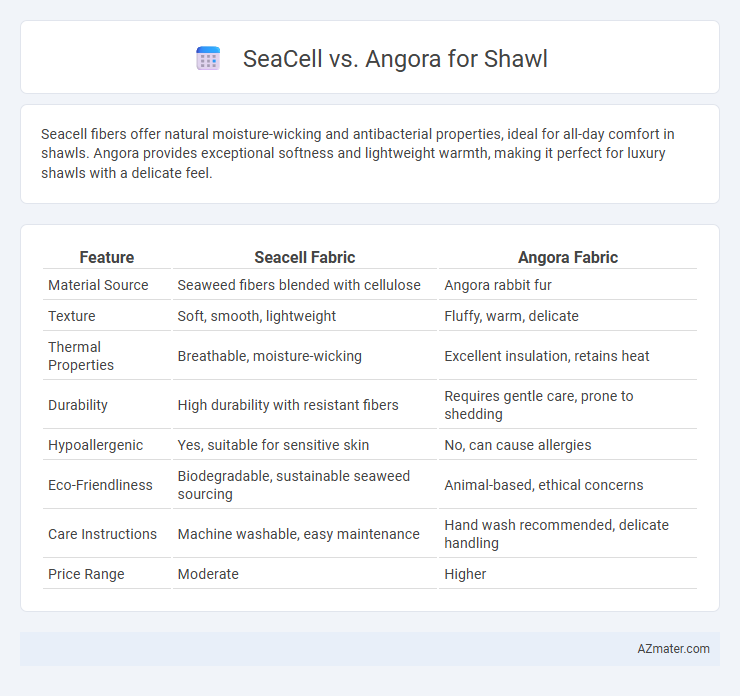Seacell fibers offer natural moisture-wicking and antibacterial properties, ideal for all-day comfort in shawls. Angora provides exceptional softness and lightweight warmth, making it perfect for luxury shawls with a delicate feel.
Table of Comparison
| Feature | Seacell Fabric | Angora Fabric |
|---|---|---|
| Material Source | Seaweed fibers blended with cellulose | Angora rabbit fur |
| Texture | Soft, smooth, lightweight | Fluffy, warm, delicate |
| Thermal Properties | Breathable, moisture-wicking | Excellent insulation, retains heat |
| Durability | High durability with resistant fibers | Requires gentle care, prone to shedding |
| Hypoallergenic | Yes, suitable for sensitive skin | No, can cause allergies |
| Eco-Friendliness | Biodegradable, sustainable seaweed sourcing | Animal-based, ethical concerns |
| Care Instructions | Machine washable, easy maintenance | Hand wash recommended, delicate handling |
| Price Range | Moderate | Higher |
Introduction to Seacell and Angora
Seacell is an innovative fabric made from seaweed fibers blended with natural cellulose, offering moisture-wicking and skin-soothing properties ideal for shawls. Angora, derived from the Angora rabbit, is prized for its exceptional softness, warmth, and lightweight feel, making it a luxurious choice for lightweight shawls. Combining Seacell's eco-friendly benefits with Angora's insulating qualities creates shawls that are both sustainable and cozy for year-round wear.
Fiber Origins: Seacell vs Angora
Seacell fiber is derived from a blend of cellulose extracted from sustainable seaweed and fine natural fibers, offering eco-friendly and skin-soothing properties. Angora fiber originates from the Angora rabbit, prized for its exceptional softness, warmth, and lightweight texture ideal for delicate shawls. The sustainable, renewable nature of Seacell contrasts with the animal-derived Angora, highlighting differences in fiber sources impacting comfort and environmental considerations in shawl production.
Sustainability and Environmental Impact
Seacell fiber, derived from seaweed and cellulose, offers exceptional sustainability due to its biodegradable nature and natural nutrient release that benefits skin while reducing environmental toxins. Angora wool, sourced from Angora rabbits, raises concerns about animal welfare and resource-intensive farming practices, contributing to higher environmental impact compared to plant-based fibers. Choosing Seacell for shawls supports eco-friendly production, lower carbon footprint, and promotes renewable raw materials in sustainable fashion.
Softness and Texture Comparison
Seacell fabric offers a silky softness with a subtle sheen, providing a smooth, breathable texture ideal for lightweight shawls. Angora, derived from rabbit hair, is known for its exceptional warmth and fluffy, plush texture, creating a cozy and luxurious feel but tends to be heavier. When comparing softness, Angora is typically softer and more insulating, while Seacell excels in moisture management and a cool, gentle touch against the skin.
Breathability and Moisture Management
Seacell fibers offer superior breathability due to their natural cellulose content, allowing air to circulate and keeping the skin cool and dry. Angora wool excels in moisture management by wicking away sweat and providing excellent insulation without trapping moisture. Combining Seacell's ventilation properties with Angora's moisture-wicking abilities results in a shawl that maintains comfort and dryness in various weather conditions.
Warmth and Insulation Qualities
Seacell fibers offer moderate warmth with natural moisture-wicking properties, making them breathable and comfortable for shawls without overheating. Angora wool provides superior insulation due to its hollow fiber structure, trapping heat effectively and delivering exceptional warmth in cold conditions. For shawls prioritizing warmth and insulation, Angora outperforms Seacell by maintaining higher thermal retention while Seacell enhances comfort through its eco-friendly and breathable characteristics.
Durability and Longevity
Seacell fibers offer excellent durability for shawls due to their blend of cellulose and seaweed extracts, providing resistance to wear and environmental damage. Angora, known for its softness, tends to be less durable as its fine fibers may pill and suffer from abrasion more easily. Therefore, shawls made with Seacell typically exhibit greater longevity compared to those made with Angora.
Allergenicity and Skin Sensitivity
Seacell fibers are derived from seaweed and cellulose, offering natural antibacterial and hypoallergenic properties that minimize allergenicity and soothe sensitive skin, making them ideal for individuals prone to irritation. Angora, coming from Angora rabbits, has a luxurious softness but can trigger allergic reactions in sensitive users due to its fine lanolin content and animal-derived proteins. Shawls made from Seacell often provide a safer, skin-friendly alternative for those with allergies or sensitive skin compared to traditional Angora options.
Care and Maintenance for Shawls
Seacell shawls require gentle hand washing with mild detergent and air drying away from direct sunlight to maintain their softness and durability. Angora shawls demand delicate care, including cold water washes with specialized wool detergent and flat drying to prevent fiber matting and shrinkage. Both materials benefit from storage in breathable bags to avoid moisture damage and preserve the shawl's texture and longevity.
Choosing the Best Yarn for Your Shawl
Seacell yarn, made from seaweed fibers blended with soft fibers like cotton or wool, offers natural antibacterial properties and excellent moisture regulation, making it ideal for sensitive skin. Angora yarn, derived from Angora rabbit fur, provides exceptional warmth and a luxurious, fluffy texture perfect for elegant shawls requiring softness and insulation. Choose Seacell for breathability and skin benefits, or Angora for warmth and plush comfort in your shawl project.

Infographic: Seacell vs Angora for Shawl
 azmater.com
azmater.com